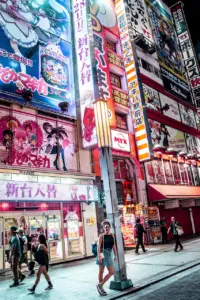Are you ready to immerse yourself in Japan’s drinking and dining culture like a local? Look no further than the izakaya, a quintessential Japanese establishment that combines the best of both worlds.
Izakayas are informal, cozy bars that offer a wide range of food and drinks, making them the perfect spot for a night out with friends or colleagues.
But izakayas are more than just places to eat and drink. They have a long history and cultural significance in Japan, dating back to the Edo period. Originally, they were establishments that served sake and small dishes to travelers, but over time they evolved into social spaces where locals could gather and unwind after a long day of work.
Today, izakayas are a beloved institution in Japan, and a must-visit for anyone looking to experience Japanese culture firsthand.
So grab a seat, order a drink, and get ready to dive into the world of izakayas.
Key Takeaways
- Izakayas are a significant part of Japanese history and culture, and offer communal dining experiences.
- These establishments serve a wide variety of dishes and drinks, making it essential to try many different options.
- It is important to follow proper etiquette, such as using the call button and sharing plates and drinks with others.
- Tokyo has numerous excellent izakayas, and visitors should take the opportunity to explore and try new things during their stay.
History and Cultural Significance of Izakayas
Izakayas have been a beloved part of Japanese culture for centuries, offering a cozy and relaxed atmosphere where locals gather to share drinks and small plates of delicious food.
These taverns first emerged during the Edo period, serving sake to traveling samurai and merchants. Over time, izakayas evolved into social hubs where friends and colleagues could unwind after a long day at work.
What sets izakayas apart from other bars or restaurants is their emphasis on communal dining. Instead of ordering individual meals, groups share a variety of dishes, from skewered meats to pickled vegetables. This tradition creates a sense of camaraderie and fosters a convivial atmosphere.
Moreover, izakayas often feature seasonal ingredients and regional specialties, providing a unique opportunity to sample the diverse cuisine of Japan. Whether you’re looking for a casual night out with friends or a taste of local culture, an izakaya is the perfect place to experience the warmth and hospitality of Japanese society.
Types of Izakayas
Get ready to experience a variety of spots where you can savor small bites and enjoy drinks with friends. There are several types of izakayas that you can find in Japan, each with its unique style and atmosphere. Whether you’re in the mood for a casual night out with friends or a more upscale dining experience, there’s an izakaya that caters to your preferences.
To help you narrow down your options, here’s a table outlining the different types of izakayas and their characteristics:
| Type of Izakaya | Characteristics |
|---|---|
| Tachinomiya | Standing bar with no seating |
| Akachochin | Red lanterns outside, traditional decor |
| Robatayaki | Grilled food cooked in front of you |
| Kushikatsu | Deep-fried skewers |
| Yakitori | Grilled chicken skewers |
No matter which type of izakaya you choose, you’re in for a treat. From the lively atmosphere of a tachinomiya to the traditional decor of an akachochin, each one offers a unique experience. So grab some friends, order some small plates, and enjoy the drinks and lively atmosphere that Japan’s izakayas have to offer.
Menu Items and Drinks
You’ll be salivating over the variety of small plates and drinks available on the menu at these authentic Japanese eateries. Izakayas offer a wide range of dishes, from classic Japanese cuisine like sushi and sashimi to more unique options like grilled chicken skewers and deep-fried tofu. Many izakayas also offer seasonal dishes, so you can try something new each time you visit.
In addition to the food, izakayas are known for their extensive drink menus. You can try a variety of sake, Japan’s traditional rice wine, which come in different grades and flavors. Beer and shochu, a distilled liquor made from grains or sweet potatoes, are also popular choices. Some izakayas even offer cocktails and wine, so there’s something for everyone.
Don’t be afraid to ask the staff for recommendations or to try something new that’s all part of the izakaya experience!
Etiquette of Ordering
When it comes to ordering at an izakaya in Japan, there are a few key points to keep in mind.
First, don’t hesitate to use the call button to signal for service.
Second, it’s common to share plates and drinks with your group, so plan accordingly.
And finally, tipping isn’t expected and payment is typically made at the end of the meal.
By following these simple etiquette guidelines, you’ll be able to fully enjoy the izakaya experience like a local.
Using the Call Button
If you’re looking to catch the attention of your server at an izakaya, simply press the call button on your table. It’s a common practice in Japan. The call button, or ‘summoning button,’ is usually located on the side of the table or attached to the wall.
Don’t hesitate to use it, as it’s a convenient way to order more drinks or food without having to flag down your server or yell across the room. However, keep in mind that there are certain etiquettes to follow when using the call button.
Here are three things to keep in mind:
-
Be patient – the server may not come immediately as they may be serving another table or preparing orders in the kitchen.
-
Use the call button for ordering only – avoid pressing it for non-order related requests, such as asking for the restroom or the bill.
-
Don’t abuse the call button – use it only when necessary, as excessive use can be seen as rude or impatient.
Sharing Plates and Drinks
To fully immerse yourself in the izakaya culture, it’s important to share plates and drinks with your group. Izakayas are known for their small plates, or ‘otsumami,’that are meant to be shared amongst friends. This allows everyone to try a variety of dishes and flavors while also promoting a sense of community and closeness.
When it comes to drinks, izakayas offer a wide range of options from beer and sake to cocktails and highballs. It’s common for groups to order a large bottle of sake or beer and share it amongst themselves, taking turns pouring for each other. This adds to the convivial atmosphere and encourages everyone to relax and have a good time.
So don’t be afraid to share plates and drinks with your group – it’s all part of the izakaya experience!
Tipping and Payment
Remember, in Japan, tipping is not customary and can even be seen as rude. So when it comes time to pay at the izakaya, simply pay the amount on the bill and don’t worry about leaving extra money for the server. This may be a bit different from what you’re used to, but it’s important to respect and adhere to local customs.
In terms of payment methods, most izakayas will accept cash as well as major credit cards. It’s always a good idea to carry some cash on you, just in case the restaurant doesn’t accept cards. Additionally, some izakayas may offer a payment option called "oshibori charge,"which is a small fee for the hot towel that’s often served at the beginning of the meal. This charge is usually only a few hundred yen and is not mandatory, but it’s a nice gesture if you want to show your appreciation for the service. Here’s a helpful table to summarize the key points about tipping and payment at izakayas:
| Tipping | Payment Methods |
|---|---|
| Not customary and can be seen as rude | Cash and major credit cards accepted |
| Some izakayas may offer "oshibori charge"for hot towel at beginning of meal |
Remember, at the end of the day, the most important thing is to enjoy your experience at the izakaya and have a good time with your companions. By following these simple guidelines, you’ll be able to navigate the world of Japanese izakayas with ease and confidence.
Dining Culture in Izakayas
In Izakayas, diners can enjoy a relaxed atmosphere while sharing small plates and drinks with friends, creating a fun and social dining experience. Unlike in Western restaurants, the focus in Izakayas isn’t on a formal dining experience, but on enjoying the company of others and trying a variety of dishes.
It’s common for groups to order multiple plates and share them family-style, allowing everyone to try a little bit of everything. In addition, Izakayas often offer a wide selection of drinks, including beer, sake, shochu, and cocktails.
It’s common for diners to order a drink that pairs well with their food, or to try a variety of drinks throughout the meal. With its casual atmosphere and emphasis on sharing, Izakayas are a popular destination for locals to unwind after work or socialize with friends on the weekends.
Recommended Izakayas in Tokyo
You’ll find that Tokyo has an abundance of top-rated Izakayas that come highly recommended by locals and travelers alike. Here are a few must-visit spots to add to your list during your time in Tokyo:
| Izakaya Name | Location | Specialty Dish | Price Range |
|---|---|---|---|
| Torikizoku | Multiple locations | Yakitori | ¥300-¥500 per dish |
| Gonpachi | Nishi-Azabu | Soba noodles | ¥1,000-¥2,000 per dish |
| Tsubohachi | Multiple locations | Sashimi | ¥1,000-¥2,000 per dish |
| Yururi | Shibuya | Okonomiyaki | ¥1,000-¥2,000 per dish |
Torikizoku is a popular Izakaya chain with locations all over Tokyo, offering delicious and affordable yakitori (grilled chicken skewers) for only Â¥300-Â¥500 per dish. Gonpachi, also known as the "Kill Bill"restaurant, is located in the trendy Nishi-Azabu neighborhood and offers a wide variety of dishes, but is most famous for its soba noodles. For fresh sashimi, head to Tsubohachi, a popular Izakaya chain with multiple locations throughout the city. And for a taste of savory okonomiyaki (a Japanese savory pancake), visit Yururi in Shibuya. These Izakayas are just a small selection of the many fantastic options available in Tokyo, so don’t hesitate to explore and try new things during your stay.
Izakaya-related Events
If you’re looking for a unique and exciting experience during your time in Tokyo, why not check out one of the many Izakaya-related events happening throughout the city? These events are a great way to immerse yourself in Japanese culture and experience the local food and drinks in a fun, social setting.
From sake tastings to beer festivals, there’s something for everyone. One popular event is the ‘Nomihodai’or all-you-can-drink parties, where customers pay a set price and can enjoy unlimited drinks for a certain amount of time. Another event to check out is the ‘Shochu Night,’where you can sample Japan’s traditional distilled spirit made from various ingredients like sweet potatoes, barley, or rice.
These events are often held at Izakayas, so you can enjoy delicious food while trying out new drinks. Don’t miss out on these fun and memorable experiences during your trip to Tokyo!
Frequently Asked Questions
What is the average cost of dining and drinking at an izakaya?
When it comes to dining and drinking at an izakaya, the average cost can vary depending on a few factors. Generally speaking, you can expect to spend around ¥3,000-¥5,000 per person for a night out at an izakaya.
Of course, this can go up or down depending on what you order, how much you drink, and the type of izakaya you choose to visit. Some izakayas may have higher end menus or specialize in premium drinks, which can increase the overall cost. However, many izakayas offer budget-friendly options as well, making it easy to enjoy a night out without breaking the bank.
Ultimately, the cost of dining and drinking at an izakaya is up to you and your preferences, but with so many options available, it’s easy to find something that suits your budget and tastes.
Are izakayas open for lunch or only dinner?
Yes, izakayas are typically open for lunch as well as dinner. This makes them a great option for those looking to grab a quick and affordable meal during the day.
Lunch at an izakaya usually consists of smaller portions, perfect for sharing with friends or colleagues. Some izakayas may also offer lunch specials and set menus, which can be a great value.
However, it’s important to note that the atmosphere at lunchtime may be more subdued compared to the energetic and lively scene at night. So whether you’re looking for a relaxing lunch or a night out with friends, an izakaya can provide a memorable dining experience any time of day.
Is it common to tip in izakayas?
Tipping in izakayas is not common. In Japan, the service fee is already included in the menu prices, so there’s no need to leave a tip.
Additionally, tipping may even be seen as rude or confusing to the staff. Instead of tipping, it’s customary to show appreciation by saying ‘gochisosama deshita’ (thank you for the meal) at the end of your meal.
If you want to go the extra mile, you can also order a round of drinks for the staff or leave a good review online. Remember that in Japan, the focus is on the quality of service and experience, not the amount of money exchanged.
Can non-Japanese speakers easily navigate the menu and order food and drinks?
Navigating the menu at an izakaya as a non-Japanese speaker can seem daunting at first, but don’t worry, it’s actually quite manageable. Most izakayas will have menus with pictures, and some may even have English translations.
However, if the menu is only in Japanese, don’t be afraid to ask the server for recommendations or for help deciphering the menu. When it comes to ordering food and drinks, pointing to the menu or using simple Japanese phrases such as "kore kudasai"(this, please) or "o-nomimono wa?"(what do you recommend to drink?) can go a long way.
And don’t forget, part of the izakaya experience is trying new things and stepping out of your comfort zone, so embrace the adventure and enjoy!
Are there any restrictions on dress code or attire when visiting an izakaya?
When visiting an izakaya, it’s important to be mindful of the dress code. While there aren’t usually any strict rules, it’s best to avoid wearing overly casual or revealing clothing.
Opt for something comfortable yet presentable, such as business casual attire. It’s also important to consider the culture and customs of Japan, so avoid wearing shoes that are difficult to remove or anything that may be considered offensive.
Overall, dressing appropriately shows respect for the establishment and the people around you, and can enhance your overall experience at the izakaya.
Conclusion
So, there you have it – a comprehensive guide to Japan’s izakayas!
From their deep cultural significance to the various types of izakayas available, we’ve covered it all.
You now know what to expect from the menu, how to order, and how to behave while dining in an izakaya.
But most importantly, you now have a list of recommended izakayas in Tokyo to try out.
So why not immerse yourself in the local culture and head to one of these establishments on your next trip?
With their casual atmosphere, delicious food and drink, and friendly locals, you’re sure to have an unforgettable experience.
So go ahead, raise a glass and cheers to the izakaya way of life!













































































